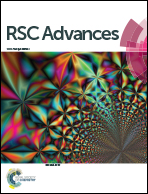Anionic structural effect on the dissolution of arabinoxylan-rich hemicellulose in 1-butyl-3-methylimidazolium carboxylate-based ionic liquids†
Abstract
The exploration of a highly efficient and environment-friendly solvent for dissolving hemicellulose is significant. In this study, 1-butyl-3-methylimidazolium carboxylate ([Bmim]carboxylate)-based ionic liquids (ILs), including [Bmim]formate, [Bmim]acetate, [Bmim]propionate, and [Bmim]butyrate, were used as solvents to dissolve arabinoxylan-rich hemicellulose from bamboo. The hemicellulose solubility in the ILs was determined as a function of temperature. The interaction between the hemicellulose and the ILs was evaluated by using 1H and 13C NMR techniques. The hemicelluloses regenerated from the saturated IL solutions were characterized. Results showed that the temperature and structure of carboxylate anions deeply affected the hemicellulose solubility. The carboxylate anion played a more important role than the imidazolium cation in hemicellulose dissolution. The hydrogen bond that formed between the ILs and the hydroxyl groups at the XC2 position of xylopyranose units of hemicellulose was stronger than that between the ILs and the hydroxyl groups at XC3 position of xylopyranose units. The hydrogen bond strength between the hemicellulose and the ILs was affected by the alkyl chain of the carboxylate anion and the hemicellulose concentration. The disruption of the inter- and intra-molecular hydrogen bonds in hemicellulose by the ILs was responsible for the hemicellulose dissolution. The main chain of hemicellulose remained nearly unchanged during the dissolution process.



 Please wait while we load your content...
Please wait while we load your content...